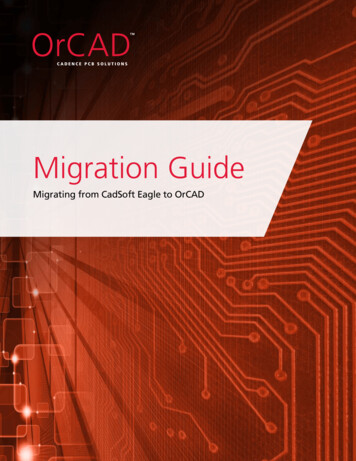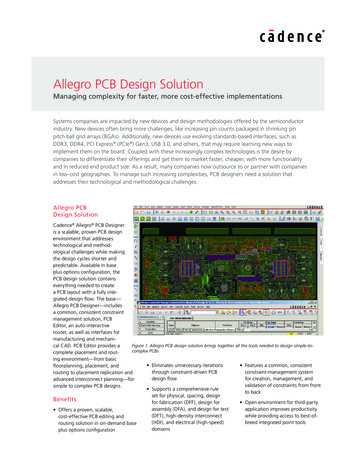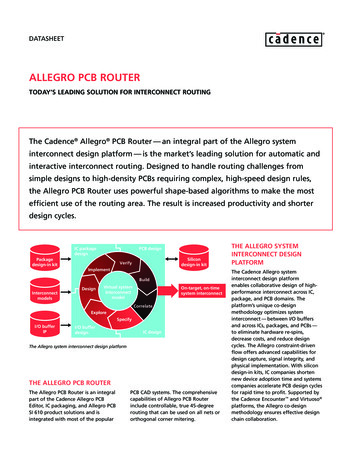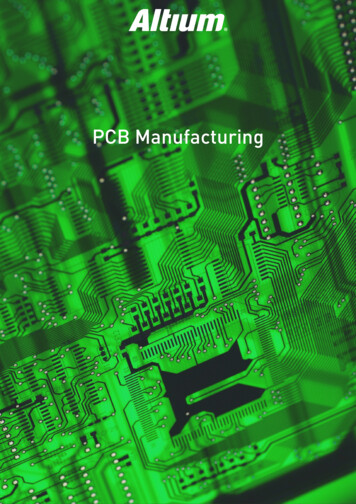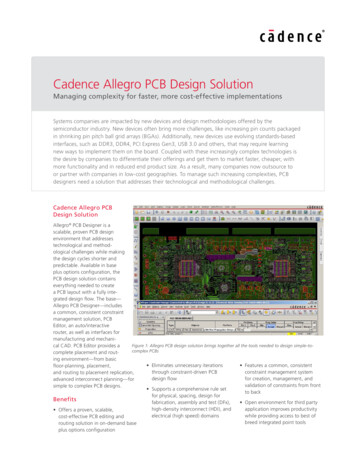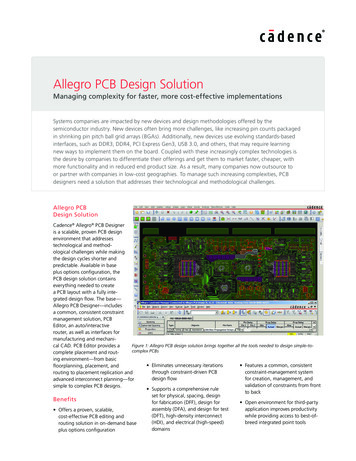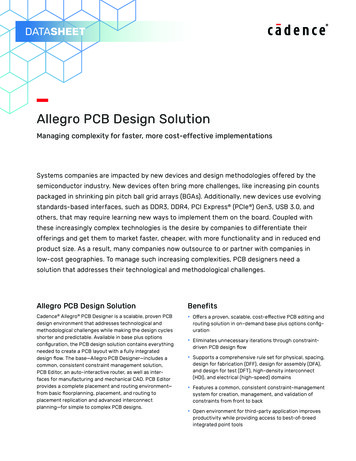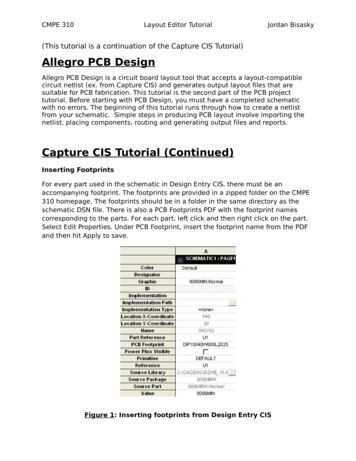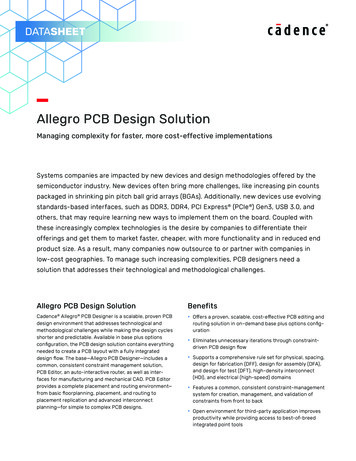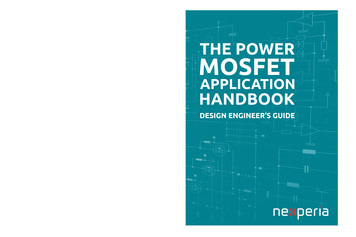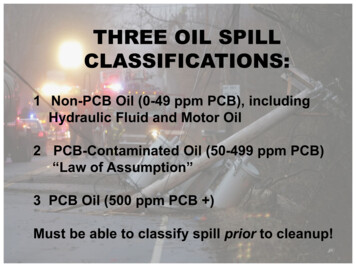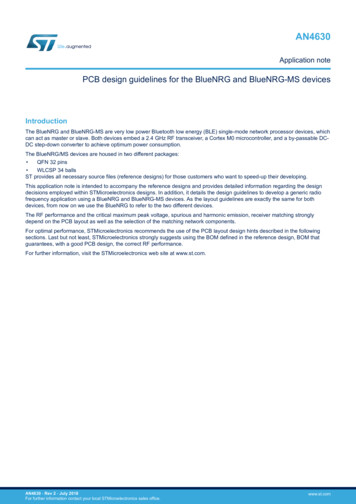
Transcription
AN4630Application notePCB design guidelines for the BlueNRG and BlueNRG-MS devicesIntroductionThe BlueNRG and BlueNRG-MS are very low power Bluetooth low energy (BLE) single-mode network processor devices, whichcan act as master or slave. Both devices embed a 2.4 GHz RF transceiver, a Cortex M0 microcontroller, and a by-passable DCDC step-down converter to achieve optimum power consumption.The BlueNRG/MS devices are housed in two different packages: QFN 32 pins WLCSP 34 ballsST provides all necessary source files (reference designs) for those customers who want to speed-up their developing.This application note is intended to accompany the reference designs and provides detailed information regarding the designdecisions employed within STMicroelectronics designs. In addition, it details the design guidelines to develop a generic radiofrequency application using a BlueNRG and BlueNRG-MS devices. As the layout guidelines are exactly the same for bothdevices, from now on we use the BlueNRG to refer to the two different devices.The RF performance and the critical maximum peak voltage, spurious and harmonic emission, receiver matching stronglydepend on the PCB layout as well as the selection of the matching network components.For optimal performance, STMicroelectronics recommends the use of the PCB layout design hints described in the followingsections. Last but not least, STMicroelectronics strongly suggests using the BOM defined in the reference design, BOM thatguarantees, with a good PCB design, the correct RF performance.For further information, visit the STMicroelectronics web site at www.st.com.AN4630 - Rev 2 - July 2018For further information contact your local STMicroelectronics sales office.www.st.com
AN4630Reference schematics1Reference schematicsDifferent application boards have been developed to show the BlueNRG device functionalities.The schematics of the different application boards are reported in the following pictures and refer to the variouspossible combinations: QFN32 package, SMD discrete balun, DC-DC converter ON (Figure 1. QFN32 package, SMD discretebalun, DC-DC converter ON); QFN32 package, SMD discrete balun, DC-DC converter OFF (Figure 2. QFN32 package, SMD discretebalun, DC-DC converter OFF); QFN32 package, integrated balun , DC-DC converter ON (Figure 3. QFN32 package, integrated balun, DCDC converter ON); CSP34 package, SMD discrete balun, DC-DC converter ON (Figure 4. CSP34 package, SMD discretebalun, DC-DC converter ON); CSP34 package, SMD discrete balun, DC-DC converter OFF (Figure 5. CSP34 package, SMD discretebalun, DC-DC converter OFF); CSP34 package , integrated balun , DC-DC converter ON (Figure 6. CSP34 package, integrated balun, DCDC converter ON);All the layout guidelines described in the next sections are to be applied to all these application boards.Figure 1. QFN32 package, SMD discrete balun, DC-DC converter ON1.7 V to 3.6 V Power SupplyC1C2C6C3L1C4C5SPI CSSPI MISOU13231302928272625 RESETNL5Application MCUC11C7C8SPI MISOSPI CSTEST10VDD1V2SMPSFILT2NO SMPSSMPSFILT1RESETNL4U2SPI MOSISPI CLKSPI IRQR1C1212345678SPI MOSISPI CLKSPI 0RF1VBAT2FXTAL0FXTAL1GND 30 - Rev 2page 2/23
AN4630Reference schematicsFigure 2. QFN32 package, SMD discrete balun, DC-DC converter OFF1.7 V to 3.6 V Power SupplyC1C6C3C5C4L5SPI CSSPI MISOU212345678SPI MOSISPI CLKSPI IRQR1C12C7SPI MISOSPI CSTEST10VDD1V2SMPSFILT2NO SMPSSMPSFILT1RESETNU1C113231302928272625 RESETNApplication MCUSPI MOSISPI CLKSPI IRQTEST1VBAT3TEST2TEST3TEST4C8L4C14GND 6BlueNRGC18L6C19C20GAMSEC2014129-1009Figure 3. QFN32 package, integrated balun, DC-DC converter ON1.7 V to 3.6 V Power SupplyC2C1C6C3L1C4C5SPI CSSPI MISOU2SPI MOSISPI CLKSPI IRQC12SPI MOSISPI CLKSPI 1VBAT2FXTAL0FXTAL1GND 8TEST9TEST11TEST12R112345678C7SPI MISOSPI CSTEST10VDD1V2SMPSFILT2NO SMPSSMPSFILT1RESETNU13231302928272625 RESETNL5Application G-01D3XTAL2C17C18L6C19C20GAMSEC2014129-1021AN4630 - Rev 2page 3/23
AN4630Reference schematicsFigure 4. CSP34 package, SMD discrete balun, DC-DC converter ON1.7 V to 3.6 V Power SupplyC2C1C6C3L1C4C5L5F1F2E3F3F5F4F6E4 RESETND4Application MCUSPI CSSPI MISOU2E2E1D2D1C1C2B1B2SPI MOSISPI CLKSPI IRQR1C12C11SPI MOSISPI CLKSPI IRQTEST1VBAT3TEST2TEST3TEST4C8C7L4SPI MISOSPI CSTEST10VDD1V2SMPSFILT2SMPS TAL2A1B3A2A3A4A5B4B5D3C17C18BlueNRG WLCSPL6C19C20GAMSEC2014129-1030Figure 5. CSP34 package, SMD discrete balun, DC-DC converter OFF1.7 V to 3.6 V Power SupplyC1C6C3C4C5SPI CSSPI MISOU2SPI MOSISPI CLKSPI IRQC12C7SPI MOSISPI CLKSPI GNDR1E2E1D2D1C1C2B1B2C11SPI MISOSPI CSTEST10VDD1V2SMPSFILT2SMPS GNDSMPSFILT1RESETNGNDU1F1F2E3F3F5F4F6E4 RESETND4L5Application MCUXTAL1C21L3C16C10C15L2XTAL2C9C17C18BlueNRG WLCSPL6C19C20GAMSEC2014129-1106AN4630 - Rev 2page 4/23
AN4630Reference schematicsFigure 6. CSP34 package, integrated balun, DC-DC converter ON1.7 V to 3.6 V Power SupplyC2C1C6C3L1C4C5SPI CSSPI MISOU2E2E1D2D1C1C2B1B2SPI MOSISPI CLKSPI IRQC12SPI MOSISPI CLKSPI DD1V8TEST8TEST9TEST11TEST12GNDR1C7SPI MISOSPI CSTEST10VDD1V2SMPSFILT2SMPS GNDSMPSFILT1RESETNGNDU1F1F2E3F3F5F4F6E4 RESETND4L5Application MCUXTAL2C17C18BlueNRG WLCSPL6C19C20GAMSEC2014129-1112Table 1. BlueNRG application board external components descriptionAN4630 - Rev 2ComponentsDescriptionC1, C6, C12Decoupling capacitors for battery voltageC2, C3DC-DC converter filtering capacitorsC4, C5Decoupling capacitor for on-chip 1.2 V voltage regulatorC19, C20Decoupling capacitor for on-chip 1.2 V voltage regulatorC9, C10, C11, C14, C15, C16, C21RF discrete balun filter/matching capacitorsC7, C8XTAL1 capacitorsC17, C18XTAL2 capacitorsL1DC-DC converter inductorL2, L3, L4RF discrete balun filter/matching inductorsL5XTAL1 filtering inductorL6XTAL2 filtering inductorR1IRQ pull-down resistorXTAL1Low-frequency crystalXTAL2High-frequency crystalU1High-frequency crystal BlueNRG QFN/CSP deviceU2Micro controllerU3Integrated balunpage 5/23
AN4630Component dimensioning2Component dimensioningThe choice of the external components is essential for the correct application functionality. In the next section, thedescription of the main components, their functionality and how to choose them are described.2.1CapacitorsA capacitor is a passive electrical component used to store energy in an electrical field. The forms of practicalcapacitors vary widely, but all contain at least two electrical conductors separated by a dielectric.Capacitors differ from each other in construction techniques and materials used to manufacture. A lot of differenttypes of capacitors exist (double-layer, polyester, polypropylene and so on), but this document focuses on thesurface mount versions of ceramics only. The other types of capacitors are not indicated neither for characteristicsnor cost for the application targeted in this document.A capacitor, as a practical device, exhibits not only capacitance but resistance and inductance as well. Asimplified schematic for the equivalent circuit is shown in Figure 7. Capacitor equivalent circuit .Figure 7. Capacitor equivalent circuitRpLRsCTypically for the capacitors the ESR (equivalent series resistance) and the ESL (equivalent series inductance) aredefined. The term ESR combines all losses, both series and parallel, in a capacitor at a given frequency so thatthe equivalent circuit is reduced to a simple R-C series connection. Same considerations for the ESL that is theequivalent series inductor comprised of three components: pad layout, capacitor height and power planespreading inductance.The main differences between ceramic dielectric types are the temperature coefficient of capacitance and thedielectric loss. COG and NP0 (negative-positive-zero, i.e 0) dielectrics have the lowest losses and are used forfiltering, matching and so on.For RF parts it is generally recommended multilayer (or monolithic) ceramic capacitors with a COG dielectricmaterial, which is a highly stable class I dielectric offering a linear temperature coefficient, low loss and stableelectrical properties over time, voltage and frequency.For RF decoupling purposes select a capacitor value such that for the frequency to be decoupled is close to orjust above the series resonant frequency (SRF) of the capacitor. At SRF the parasitic impedance resonates withthe device capacitance to form a series tuned circuit and the impedance presented by the capacitor is theeffective series resistance (ESR).For DC blocking or coupling applications at RF, typically a capacitor with low insertion loss and a good qualityfactor is required. Since a capacitor’s quality factor is inversely proportional to its ESR, select a capacitor with alow ESR and ensure that the SRF of the capacitor is greater than the frequency of operation. If the workingfrequency is above the SRF of the capacitor, it appears inductive.Note:AN4630 - Rev 2All the capacitors of the BlueNRG application board used for the matching network and for the crystals have tobe C0G.page 6/23
AN4630Inductors2.2InductorsAn inductor is a passive electrical component used to store energy in its magnetic field. Any conductor hasinductance. An inductor is typically made of wire or other conductor wound into a coil, to increase the magneticfield.Inductors differ from each other for construction techniques and materials used to manufacture. A lot of differenttypes of inductors exist (air core inductor, ferromagnetic core inductor, and variable inductor), but this documentwill focus on the inductors useful for RF only. Usually in RF the air core inductors are used. The term air coredescribes an inductor that does not use a magnetic core made of ferromagnetic material, but coil wound onplastic, ceramic, or another nonmagnetic form. They are lower inductance than ferromagnetic core coils but areused at high frequencies because they are free from energy losses called core losses.Usually, the real circuit of an inductor is composed of a series resistance and a parallel capacitor. The parallelcapacitor is considered to be the inter-winding capacitance that exists the turns of the inductor. If the inductor isplaced over a ground plane then, this capacitance also includes the capacitance that exists between the inductorand the ground plane. The series resistor can be considered as the resistance of the inductor winding.In term of circuit performance, as already mentioned for the capacitors, the self-resonant frequency and thequality factor are the main inductor parameters, especially for the circuit where the losses need to be minimized.At the self-resonant frequency, the inductor impedance is at maximum. For frequency above the self-resonancethe inductor behavior change and it appears capacitive.In general wire wound inductors have a higher quality factor than a multilayer equivalent. They also reflect andradiate more energy that can give rise to higher emission levels, especially in term of self-coupling. Inductivecoupling can give rise to undesired circuit operation: to minimize coupling mount the inductors in sensitive circuitareas at 90 degrees to one another.In the BlueNRG application board two different inductor types are used:1.DC-DC converter coil: the BlueNRG supports 10 µH only, while the BlueNRG-MS supports 4.7 or 10 µH(program the desired configuration inside the IFR). The DCR has to be less than 1 ohm; the rated currenthas to be higher than 100 mA.2.RF matching and filtering coil: in this case the best solutions are the high Q coils, but a good compromisebetween application cost versus RF performances is to choose an inductor with a medium Q.2.3External quartsThe BlueNRG includes a high frequency and a low-frequency integrated oscillators that required two externalcrystals.The BlueNRG includes a fully integrated, low power 16/32 MHz Xtal oscillator with an embedded amplituderegulation loop. In order to achieve low power operation and good frequency stability of the Xtal oscillator, certainconsiderations with respect to the quartz load capacitance C0 need to be taken into account. Figure 8. Diagram ofthe BlueNRG amplitude regulated oscillator shows a simplified block diagram of the amplitude regulated oscillatorused on the BlueNRG.AN4630 - Rev 2page 7/23
AN4630External quartsFigure 8. Diagram of the BlueNRG amplitude regulated oscillatorGAMSEC2014129 -1141Low power consumption and fast startup time are achieved by choosing a quartz crystal with a small loadcapacitance C0. A reasonable choice for capacitor C0 is 15 pF. To achieve good frequency stability, the followingequation needs to be satisfied:Equation 1Where C1’ C1 CPCB1 CPAD, C2’ C2 CPCB2 CPAD, where C1 and C2 are external (SMD) components,CPCB1 and CPCB2 are PCB routing parasites and CPAD is the equivalent small-signal pad-capacitance. Thevalue of CPAD is around 0.5 pF for each pad. The routing parasites should be minimized by placing quartz andC1/C2 capacitors close to the chip, not only for an easier matching of the load capacitance C0, but also to ensurerobustness against noise injection. Connect each capacitor of the Xtal oscillator to ground by a separate via.Regarding the low-frequency crystal oscillator the same consideration has to be done.It is important to underline that the BlueNRG and BlueNRG-MS integrate an internal low-frequency RC oscillatorthat works without external quartz. The internal low-frequency RC oscillator can be chosen as an alternative to thelow-frequency crystal oscillator, which works with a 32 kHz crystal. The BlueNRG and BlueNRG-MS also integratean internal high-frequency RC oscillator, but it is disabled after an initial system bootstrap, so it is necessary touse an external quartz for radio operations.AN4630 - Rev 2page 8/23
AN4630Two or multi-layer application boards3Two or multi-layer application boardsDifferent approach has to be taken into account when an application board is designed using the QFN32 or theWLCSP34 package.3.1QFN32 packageIn this case the best solution is to use a two-layer application board.Figure 9. QFN32 package application board stack-up layerThe two layers have to be so distributed:1.TOP layer: used for routing.2.BOTTOM layer: used for grounding under the RF zones and for routing on the rest.3.2WLCSP34 packageIn this case, it is not possible to design a two-layer board and the stack-up layer is a multilayer due to thecomplexity of the package. In Figure 10. WLCSP34 package application board stack-up layer the suggestedstack-up layer.Figure 10. WLCSP34 package application board stack-up layerIn this case a four-layer solution is used. Also, a more complicated and expensive technology has to be used toconnect the tracks to the internal balls. The four layers have to be distributed as follows:1.TOP layer: used for routing2.INNER2 layer: used for routing3.INNER3 layer: used only for ground4.BOTTOM layer: used for routingThe filled laser vias and the buried vias have to be used in this case. The thickness between the TOP layer andthe INNER2 layer has to be 80 um. The thickness between the TOP layer and the INNER3 layer has to be 300um. The thickness between the INNER3 layer and the BOTTOM layer can be chosen according to the customernecessity.AN4630 - Rev 2page 9/23
AN4630Design recommendations when using QFN32 package4Design recommendations when using QFN32 packageThe application board TOP layer layout using the QFN32 package is shown in Figure 11. QFN32 packageapplication board TOP layer.Figure 11. QFN32 package application board TOP layerIt is crucial to connect very well the ground of the exposed pad of the QFN32 to the ground on the applicationboard. So many vias are necessary to be sure that the parasitic inductor introduced from each via is negligible.Figure 12. Vias on the exposed pad of the QFN32 packageThe ground of the two external crystals has to be isolated from the ground of the RF part of the board. This isbecause the RF ground is “dirty” and this signal can disturb the correct functionality of the two crystals. Also toreduce the coupling effects some cunning have to be taken: In the high-frequency crystal the load capacitor of theFXTAL0, pin 18, has to be connected to ground in series with an inductor (see Figure 13. High-frequency crystalinductor); In the low-frequency crystal the ground part of two load capacitors have to be connected together and,AN4630 - Rev 2page 10/23
AN4630Design recommendations when using QFN32 packageafter, connected to the ground by an inductor. The two tracks that connect the low-frequency crystal to theSXTAL0 and SXTAL1, pins 23 and 22, have to be put in a layer different from the TOP.Figure 13. High-frequency crystal inductorFigure 14. Low-frequency crystal inductor and tracksThe DC-DC converter area is very sensitive, and it is necessary to pay attention to the layout of this part. This isbecause the DC-DC converter generates GND noise that can get coupled on surrounding ground reducing thesensitivity, and high-frequency components can be coupled onto RF part. So to ensure a correct layout it isnecessary of: Providing efficient filtering by placing capacitors as close as possible from the BlueNRG; Reducingparasitic ensuring wide and short connections to BlueNRG. In Figure 15. DC-DC converter layout zone thesuggested layout is shown DC-DC converter inductor DC-DC converter filtering capacitorsAN4630 - Rev 2page 11/23
AN4630Design recommendations when using QFN32 packageFigure 15. DC-DC converter layout zoneParticular care has to be taken in the placement of the supply voltage filtering capacitors. It is, in fact, important toensure efficient filtering placing these capacitors as close as possible from their dedicated pins on the BlueNRG.The TX/RX part of the BlueNRG is a very sensitive part. The discrete balun has to be placed as close as possibleto the TX/RX pins. The traces that connect the RF pins to the balun network (differential trace) should be of equallength. If the two differential signals are unbalanced, common-mode issues can be generated. The differentialtraces have to be routed firmly together. Differential receivers are designed to be sensitive to the differencebetween a pair of inputs, but also to be insensitive to a common-mode shift of those input. Therefore, if anyexternal noise is coupled equally into the differential traces, the receiver will be insensitive to this ( standard modecoupled ) noise. More closely differential traces are routed together, more equal will any coupled noise be on eachtrace, therefore better will be the rejection of the noise in the circuit.The parallel inductors in the balun (and ingeneral) should be mutually perpendicular to avoid mutual couplings. If no perpendicular position is possible, turnaway their interposing capacitors or resistors.The interconnections between the elements are not consideredtransmission lines because their lengths are much shorter than the wavelength and, thus, their impedance is notcritical. As results, their recommended width is smallest possible. In this way, the parasitic capacitances to groundcan be minimized.Figure 16. Discrete balun layout zoneAn application board using an integrated balun was also designed . The integrated balun was developed internallyto STMicroelectronics and can be used only with the BlueNRG/MS device. It is mandatory to follow the layoutrules described in the balun datasheet (BALF-NRG-01D3).AN4630 - Rev 2page 12/23
AN4630Design recommendations when using WLCSP34 package5Design recommendations when using WLCSP34 packageThe application board for the WLCSP34 package was designed in a four-layer due the more complexity to treatthe CSP package. The print of the four layers is shown in Figure 17. WLCSP34 four-layer board.Figure 17. WLCSP34 four-layer boardA good ground connection is essential for the RF performances. This point is important for all RF devices in allpackages, but it is critical in a CSP package due to the reduced dimension of the device. A good groundconnection, that means low resistance between the ground balls of the device and the ground layer, produces alow cross talk among critical blocks that means RF performance not impacted.The ground connection of the BlueNRG in WLCSP package on the TOP layer is shown in Figure 18. WLCSP34ground connection (TOP layer view). Laser vias are used to connect TOP layer ground and INNER2 layer ground.The ground laser vias have to be put under GND balls, under the GND SMPS ball and under the unused balls. Inthe TOP layer the GND SMPS has to be kept separated from the GND.Figure 18. WLCSP34 ground connection (TOP layer view)In the INNER2 layer, Figure 19. WLCSP34 ground connection (INNER2 layer view), buried filled vias have to beused to connect INNER2 layer ground and INNER 3 layer ground. The buried filled vias have to be put with 400um of offset (both in x and y directions) respect to laser vias.In the INNER2 layer the GND SMPS has to be kept separated from the GND.It is necessary not put ground layer under the RF discrete balun. This is because due to the very little distancebetween TOP and INNER2 layers; 80 um, the parasitic capacitances would be too big and would not be possibleto find a working solution of the matching network.AN4630 - Rev 2page 13/23
AN4630Design recommendations when using WLCSP34 packageFigure 19. WLCSP34 ground connection (INNER2 layer view)In the INNER3 layer, Figure 20. WLCSP34 ground connection (INNER3 layer view), GND and GND SMPS haveto be connected together. This layer has to be kept as continue as possible to obtain a good ground that meansless noise.Figure 20. WLCSP34 ground connection (INNER3 layer view)GAMSEC20141211-1126To guarantee the RF performances with the DC-DC converter ON it is important to have an effective filteringbetween VBAT1 and SMPS GND pins. This filtering is obtained using some filtering capacitors are shown inFigure 21. Focus on power supply pins. The C6 and C8 capacitors between the VBAT1 and the SMPS GNDhave to be put as close as possible to the WLCSP. The width of the connection tracks has to be increased asmuch as possible. The TOP layer or the INNER2 layer has to be used to route these tracks.AN4630 - Rev 2page 14/23
AN4630Design recommendations when using WLCSP34 packageFigure 21. Focus on power supply pinsGAMSEC20141211-1103To guarantee the RF performances with the DC-DC converter ON it is important also to have an effective filteringbetween SMPSFILT2 and GND pins. This filtering is obtained using some filtering capacitors are shown in Figure22. Focus on BlueNRG biasing pins. The C9 and C10 capacitors between the SMPSFILT2 and the GND have tobe put as close as possible to the WLCSP. The width of the connection tracks has to be increased as much aspossible. The TOP layer or the INNER2 layer has to be used to route these tracks. The L1 inductor has to be alsoput as close as possible to the BlueNRG device.The capacitors C4 and C7 to filter the VDD 1V2 and VDD 1V8 balls have to be also put as near as possible tothe device.Figure 22. Focus on BlueNRG biasing pinsGAMSEC20141211-1056On TOP layer avoid putting metal inside the red zone. This zone is very sensible to the ground layer and thepresence of a metal plane can affect the operation of the device.The VBAT1 connection is improved using two laser filled vias.AN4630 - Rev 2page 15/23
AN4630Design recommendations when using WLCSP34 packageFigure 23. Other TOP layer constraintsGAMSEC20141211-1045The RF ground in the TOP layer is “hot” so it could generate pulling power. To avoid this risk, it is necessary to notmerge the RF ground to the others ground on the TOP and INNER2 layers, but merge all the different grounds inthe INNER3 layer.Figure 24. RF ground on the discrete balun application boardTo design the board with the integrated balun as matching network all the above suggestions has to beimplemented. The only difference is located in the balun zone where the datasheet recommendation has to befollowed. Particular attention to the ground must be observed: also in this case the RF ground in the TOP layer is“hot” and it could generate pulling. The RF TOP layer ground has to be extended to the balun zone (see Figure25. RF ground on the integrated balun application board ), but has to be merged to the other ground on theINNER3 layer.AN4630 - Rev 2page 16/23
AN4630Design recommendations when using WLCSP34 packageFigure 25. RF ground on the integrated balun application boardThe high-frequency crystal has to be put as far as possible from the matching network. The tracks that connectthe crystal pins to the BlueNRG FXTAL0 and FXTAL1 pins have to be routed as far as possible from the matchingnetwork, and also have to be kept as far as possible one from each other. The INNER2 layer has to be used toconnect the crystal pins to the BlueNRG FXTAL0 and FXTAL1 pins. The INNER2 layer has to be keeping emptyunder the crystal. All these recommendations are shown in Figure 26. High-frequency crystal connection.Figure 26. High-frequency crystal connectionGAMSEC20141211-1014The low-frequency crystal has to be put as far as possible from the matching network. The tracks that connect thecrystal pins to the BlueNRG SXTAL0 and SXTAL1 pins have to be routed as far as possible from the matchingnetwork, and also have to be kept as far as possible one from each other. The INNER2 layer has to be used toconnect the crystal pins to the BlueNRG FXTAL0 and FXTAL1 pins. The INNER2 layer has to be keeping emptyunder the crystal. All these recommendations are shown in Figure 27. Low-frequency crystal connection.AN4630 - Rev 2page 17/23
AN4630Design recommendations when using WLCSP34 packageFigure 27. Low-frequency crystal connectionGAMSEC20141211-1006The DC-DC converter inductor has to be placed as close as possible to the BlueNRG. The INNER2 layer has tobe kept empty under the DC-DC converter inductor. All these recommendations are shown in Figure 28. DC-DCconverter inductor connection.Figure 28. DC-DC converter inductor connectionGAMSEC20141211-0953AN4630 - Rev 2page 18/23
AN4630References6ReferencesReferences[1] BlueNRG datasheet[2] BlueNRG-MS datasheet[3] BALF-NRG-01D3 datasheetAN4630 - Rev 2page 19/23
AN4630Revision historyTable 2. Revision historyAN4630 - Rev 2DateVersion15-Jan-2015120-Jul-20182ChangesInitial release.Updated Section 2.2 Inductors.Minor text changes.page 20/23
AN4630ContentsContents1Reference schematics . . . . . . . . . . . . . . . . . . . . . . . . . . . . . . . . . . . . . . . . . . . . . . . . . . . . . . . . . . . . . 22Components dimensioning . . . . . . . . . . . . . . . . . . . . . . . . . . . . . . . . . . . . . . . . . . . . . . . . . . . . . . . . 632.1Capacitors . . . . . . . . . . . . . . . . . . . . . . . . . . . . . . . . . . . . . . . . . . . . . . . . . . . . . . . . . . . . . . . . . . . . 62.2Inductors. . . . . . . . . . . . . . . . . . . . . . . . . . . . . . . . . . . . . . . . . . . . . . . . . . . . . . . . . . . . . . . . . . . . . . 62.3External quarts . . . . . . . . . . . . . . . . . . . . . . . . . . . . . . . . . . . . . . . . . . . . . . . . . . . . . . . . . . . . . . . . 7Two or multi-layer application boards . . . . . . . . . . . . . . . . . . . . . . . . . . . . . . . . . . . . . . . . . . . . . . 93.1QFN32 package . . . . . . . . . . . . . . . . . . . . . . . . . . . . . . . . . . . . . . . . . . . . . . . . . . . . . . . . . . . . . . . 93.2WLCSP34 package. . . . . . . . . . . . . . . . . . . . . . . . . . . . . . . . . . . . . . . . . . . . . . . . . . . . . . . . . . . . . 94Design recommendations when using QFN32 package . . . . . . . . . . . . . . . . . . . . . . . . . . . .105Design recommendations when using WLCSP34 package . . . . . . . . . . . . . . . . . . . . . . . . .136References . . . . . . . . . . . . . . . . . . . . . . . . . . . . . . . . . . . . . . . . . . . . . . . . . . . . . . . . . . . . . . . . . . . . . . .19Revision history . . . . . . . . . . . . . . . . . . . . . . . . . . . . . . . . . . . . . . . . . . . . . . . . . . . . . . . . . . . . . . . . . . . . . . .20AN4630 - Rev 2page 21/23
AN4630List of figuresList of figuresFigure 1.Figure 2.Figure 3.Figure 4.Figure 5.Figure 6.Figure 7.Figure 8.Figure 9.Figure 10.Figure 11.Figure 12.Figure 13.Figure 14.Figure 15.Figure 16.Figure 17.Figure 18.Figure 19.Figure 20.Figure 21.Figure 22.Figure 23.Figure 24.Figure 25.Figure 26.Figure 27.Figure 28.AN4630 - Rev 2QFN32 package, SMD discrete balun, DC-DC converter ON .QFN32 package, SMD discrete balun, DC-DC converter OFF.QFN32 package, integrated balun, DC-DC converter ON . . . .CSP34 package, SMD discrete balun, DC-DC converter ON .CSP34 package, SMD discrete balun, DC-DC converter OFF.CSP34 package, integrated balun, DC-DC converter ON . . . .Capacitor equivalent circuit . . . . . . . . . . . . . . . . . . . . . . . .Diagram of the BlueNRG amplitude regulated oscillator . . . . .QFN32 package application board stack-up layer . . . . . . . . .WLCSP34 package application board stack-up layer . . . . . .QFN32 package application board TOP layer . . . . . . . . . . . .Vias on the exposed pad of the QFN32 package. . . . . . . . . .High-
This application note is intended to accompany the reference designs and provides detailed information regarding the design decisions employed within STMicroelectronics designs. In addition, it details the design guidelines to develop a generic radio frequency application using a BlueNRG and BlueNRG-MS devices.
